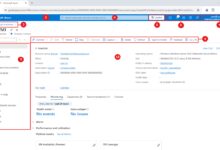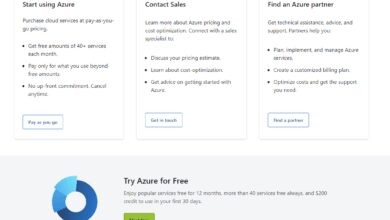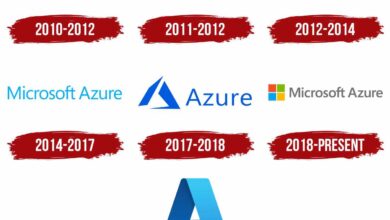Azure What Is: 7 Powerful Insights You Must Know Now
If you’ve ever wondered ‘Azure what is’ and felt lost in the cloud, you’re not alone. Let’s demystify Microsoft Azure in the simplest, most powerful way possible—no jargon, just clarity.
Azure What Is: A Complete Beginner’s Guide

When people ask ‘Azure what is’, they’re often looking for a straightforward answer to a surprisingly complex question. At its core, Microsoft Azure is a cloud computing platform created by Microsoft to help businesses build, run, and manage applications through Microsoft-managed data centers. But that definition only scratches the surface.
Defining Cloud Computing First
Before diving into Azure, it’s essential to understand what cloud computing means. Cloud computing refers to delivering computing services—including servers, storage, databases, networking, software, analytics, and intelligence—over the Internet (“the cloud”) to offer faster innovation, flexible resources, and economies of scale.
- Instead of owning physical servers, companies rent access to resources from cloud providers.
- These services are available on-demand, scalable, and often pay-as-you-go.
- Major cloud providers include Amazon Web Services (AWS), Google Cloud Platform (GCP), and Microsoft Azure.
How Azure Fits Into the Cloud Ecosystem
Microsoft Azure is one of the top three cloud platforms globally, competing directly with AWS and GCP. According to Gartner’s 2023 market analysis, Azure holds approximately 22% of the global Infrastructure as a Service (IaaS) market, second only to AWS.
“Azure is not just a cloud platform; it’s a comprehensive ecosystem enabling digital transformation.” — Microsoft Cloud Report, 2023
What sets Azure apart is its deep integration with Microsoft products like Windows Server, Active Directory, Office 365, and Dynamics 365. This makes it especially appealing to enterprises already embedded in the Microsoft ecosystem.
Azure What Is: Core Services Explained
Understanding ‘Azure what is’ means exploring the key services it offers. Azure isn’t a single product—it’s a vast collection of over 200 services designed for various computing needs. Let’s break down the most essential ones.
Compute Services: Powering Your Applications
Azure provides multiple compute options depending on your workload:
azure what is – Azure what is menjadi aspek penting yang dibahas di sini.
- Virtual Machines (VMs): Allow you to run Windows or Linux in the cloud with full control over the OS and configuration.
- Azure App Service: A fully managed platform for building web apps, mobile backends, and RESTful APIs without managing infrastructure.
- Azure Functions: A serverless compute service that runs code in response to events, scaling automatically.
- Container Instances & Kubernetes Service (AKS): For deploying and managing containerized applications at scale.
These services allow developers to choose the right level of control and abstraction for their projects.
Storage and Data Management
Data is the lifeblood of modern applications, and Azure offers robust solutions:
- Azure Blob Storage: Ideal for storing massive amounts of unstructured data like images, videos, and backups.
- Azure Files: Provides fully managed file shares in the cloud accessible via SMB or NFS protocols.
- Azure SQL Database: A fully managed relational database powered by SQL Server, with built-in high availability and AI-driven performance tuning.
- Azure Cosmos DB: A globally distributed, multi-model database service designed for low latency and high scalability.
Each storage option is designed with redundancy, security, and compliance in mind, ensuring your data is safe and accessible.
Networking and Connectivity
Azure’s networking capabilities ensure secure and efficient communication between services and users:
- Azure Virtual Network (VNet): Enables isolated environments in Azure, similar to traditional on-premises networks.
- Azure Load Balancer: Distributes incoming traffic across multiple VMs to ensure high availability.
- Azure DNS: Hosts your domain names in the cloud with low latency and high reliability.
- ExpressRoute: Offers private connections between on-premises infrastructure and Azure, bypassing the public internet for enhanced security and performance.
These tools are critical for hybrid cloud setups, where organizations maintain some infrastructure on-site while leveraging the cloud for scalability.
Azure What Is: Benefits of Using Microsoft’s Cloud Platform
Now that we’ve covered the basics, let’s explore why so many organizations are choosing Azure. The answer to ‘Azure what is’ isn’t just technical—it’s strategic.
Scalability and Flexibility
One of the biggest advantages of Azure is its ability to scale resources up or down based on demand. Whether you’re launching a new app that suddenly goes viral or need to handle seasonal traffic spikes, Azure automatically adjusts to your needs.
azure what is – Azure what is menjadi aspek penting yang dibahas di sini.
- You can scale vertically (bigger VMs) or horizontally (more instances).
- Auto-scaling rules can be set based on CPU usage, memory, or custom metrics.
- This flexibility reduces the risk of over-provisioning and saves costs.
Cost Efficiency and Pay-As-You-Go Model
Unlike traditional IT infrastructure, where you must invest heavily upfront in hardware, Azure operates on a pay-as-you-go pricing model. You only pay for what you use.
- No long-term contracts required.
- Reserved instances offer discounts of up to 72% for predictable workloads.
- Free tier available for new users with $200 credit for 30 days.
According to a Microsoft Total Cost of Ownership (TCO) calculator, businesses can save up to 40% on IT infrastructure costs by moving to Azure.
Global Reach and High Availability
Azure operates in 60+ geographic regions worldwide, more than any other cloud provider. This global footprint allows businesses to deploy applications close to their users, reducing latency and improving performance.
- Services are replicated across multiple data centers within a region for redundancy.
- Disaster recovery options like Azure Site Recovery ensure business continuity.
- Compliance with local data sovereignty laws (e.g., GDPR in Europe) is built into regional deployments.
This makes Azure ideal for multinational companies needing consistent performance and regulatory compliance.
Azure What Is: Security and Compliance Features
Security is a top concern for any organization moving to the cloud. So, when asking ‘Azure what is’, it’s crucial to understand how Azure protects your data and applications.
Built-In Security Tools
Azure offers a comprehensive suite of security services:
- Azure Security Center: Now part of Microsoft Defender for Cloud, it provides unified security management and advanced threat protection across hybrid cloud environments.
- Azure Active Directory (AAD): Manages user identities and access, enabling single sign-on (SSO) and multi-factor authentication (MFA).
- Azure Key Vault: Safely stores and manages cryptographic keys, passwords, and certificates.
- Network Security Groups (NSGs): Act as virtual firewalls to control inbound and outbound traffic to Azure resources.
These tools help organizations enforce zero-trust security models and reduce the attack surface.
azure what is – Azure what is menjadi aspek penting yang dibahas di sini.
Compliance and Certifications
Azure meets more compliance standards than any other cloud provider, including:
- GDPR (General Data Protection Regulation)
- ISO/IEC 27001, 27017, 27018
- HIPAA (Health Insurance Portability and Accountability Act)
- SOC 1, SOC 2, SOC 3
- PCI DSS (Payment Card Industry Data Security Standard)
This makes Azure a trusted choice for industries with strict regulatory requirements like healthcare, finance, and government.
Threat Detection and Response
Azure doesn’t just prevent attacks—it detects and responds to them in real time:
- Microsoft Sentinel: A cloud-native Security Information and Event Management (SIEM) system that uses AI to detect threats.
- Azure Monitor: Collects logs and metrics to identify anomalies and performance issues.
- Automated Playbooks: Use Azure Logic Apps to automate incident response workflows.
These capabilities allow security teams to respond faster and minimize damage during breaches.
Azure What Is: Integration with Microsoft Ecosystem
One of Azure’s biggest strengths is its seamless integration with other Microsoft products. This synergy is a game-changer for businesses already using Microsoft tools.
Seamless Office 365 and Dynamics 365 Integration
Azure enhances productivity and business operations by connecting directly with Microsoft 365 and Dynamics 365:
- Custom workflows in Power Automate can trigger Azure Functions.
- Dynamics 365 data can be analyzed using Azure Synapse Analytics.
- Teams integrations allow bots hosted on Azure to interact with users.
This integration reduces development time and improves user experience across platforms.
azure what is – Azure what is menjadi aspek penting yang dibahas di sini.
Hybrid Cloud with Windows Server and System Center
For organizations not ready to go fully cloud, Azure offers hybrid solutions:
- Azure Arc: Extends Azure management to on-premises servers, edge devices, and multi-cloud environments.
- Azure Stack: Brings Azure services into your own data center.
- System Center integration: Allows unified management of physical, virtual, and cloud resources.
This flexibility ensures a smooth transition to the cloud without abandoning existing infrastructure.
Developer Tools: Visual Studio and GitHub
Azure works hand-in-hand with Microsoft’s developer tools:
- Visual Studio and Visual Studio Code have built-in Azure extensions for deployment and debugging.
- GitHub Actions can deploy directly to Azure App Services or Functions.
- Azure DevOps provides CI/CD pipelines, project management, and artifact repositories.
This tight integration accelerates software development and improves collaboration among teams.
Azure What Is: Real-World Use Cases
The true value of Azure becomes clear when we look at how real organizations use it. Let’s explore some practical applications.
Enterprise Application Hosting
Many large companies use Azure to host mission-critical applications:
- General Electric uses Azure to power its industrial IoT platform, Predix.
- ASOS, the online fashion retailer, migrated its e-commerce platform to Azure for better scalability during peak seasons.
- Unilever uses Azure to run SAP workloads in the cloud, improving global operations.
These examples show how Azure supports complex, high-traffic enterprise systems.
azure what is – Azure what is menjadi aspek penting yang dibahas di sini.
Data Analytics and AI Solutions
Azure enables powerful data-driven decision-making:
- Azure Synapse Analytics: Combines big data and data warehousing into a single service.
- Azure Machine Learning: Allows data scientists to build, train, and deploy ML models at scale.
- Cognitive Services: Pre-built AI models for vision, speech, language, and decision-making.
For example, Rolls-Royce uses Azure AI to analyze jet engine data and predict maintenance needs, reducing downtime and costs.
Disaster Recovery and Backup
Business continuity is critical, and Azure excels here:
- Azure Site Recovery: Replicates on-premises VMs to Azure for failover during outages.
- Azure Backup: Provides automated, encrypted backups for VMs, files, and databases.
- Recovery Point Objective (RPO) as low as 5 minutes and Recovery Time Objective (RTO) under 30 minutes.
Organizations like the UK National Health Service (NHS) rely on Azure for disaster recovery to ensure patient data remains accessible during emergencies.
Azure What Is: Getting Started Guide
If you’re ready to explore Azure, here’s how to begin your journey.
Creating an Azure Account
Getting started is simple:
- Visit Azure Free Account and sign up with your Microsoft account.
- You’ll get $200 in credits valid for 30 days and access to over 25 always-free services.
- No credit card is required for the free tier (in most regions).
This allows you to experiment risk-free before committing financially.
azure what is – Azure what is menjadi aspek penting yang dibahas di sini.
Navigating the Azure Portal
The Azure Portal (portal.azure.com) is your central hub for managing resources:
- The dashboard is customizable with widgets for monitoring key metrics.
- Resource groups help organize related services (e.g., all components of a web app).
- The search bar lets you quickly find services like “Virtual Machines” or “Storage Accounts”.
Spend time exploring the interface—it’s intuitive once you get familiar with it.
Deploying Your First Resource
Let’s deploy a simple web app:
- Click “Create a resource” > “Web” > “Web App”.
- Choose a name, runtime stack (e.g., .NET, Node.js), and region.
- Azure automatically provisions the required App Service plan and storage.
- Once deployed, you can upload your code via FTP, Git, or CI/CD pipelines.
This hands-on experience demystifies cloud deployment and builds confidence.
Azure What Is: Future Trends and Innovations
The cloud is evolving rapidly, and Azure is at the forefront of innovation. Understanding future trends helps answer ‘Azure what is’ in a forward-looking context.
AI and Machine Learning Expansion
Microsoft is heavily investing in AI, integrating it deeply into Azure:
- Azure OpenAI Service provides access to models like GPT-3.5 and GPT-4 for enterprise use.
- AI-powered optimization in Azure Advisor suggests cost and performance improvements.
- Custom vision models can be trained using Azure Cognitive Services.
As AI becomes more accessible, Azure positions itself as the go-to platform for responsible, scalable AI deployment.
azure what is – Azure what is menjadi aspek penting yang dibahas di sini.
Edge Computing with Azure IoT
With the rise of IoT, processing data closer to the source (at the edge) is crucial:
- Azure IoT Edge: Runs cloud logic on edge devices like sensors and gateways.
- Azure Sphere: Secures microcontroller-based devices with hardware and OS protection.
- Used in manufacturing, retail, and smart cities for real-time analytics.
This reduces latency and bandwidth usage, enabling faster decision-making in remote locations.
Sustainability and Green Cloud Initiatives
Microsoft has committed to being carbon negative by 2030, and Azure plays a key role:
- Azure data centers use renewable energy and advanced cooling systems.
- The Azure Sustainability Calculator helps estimate your carbon footprint.
- Efficient resource utilization reduces energy waste.
Choosing Azure isn’t just about technology—it’s also a step toward sustainable IT practices.
What is Azure used for?
Azure is used for a wide range of purposes including hosting web applications, running virtual machines, storing data, building AI models, managing IoT devices, and enabling hybrid cloud environments. It’s also widely used for disaster recovery, analytics, and enterprise software integration.
Is Azure free to use?
azure what is – Azure what is menjadi aspek penting yang dibahas di sini.
Azure offers a free tier with $200 in credits for new users and access to over 25 always-free services. While not entirely free, it allows users to explore the platform without upfront costs. After the free period, standard pay-as-you-go pricing applies.
How does Azure compare to AWS?
Azure and AWS are both leading cloud platforms. Azure excels in integration with Microsoft products and hybrid cloud scenarios, while AWS has a broader global presence and slightly more mature service offerings. The choice often depends on existing infrastructure and business needs.
Do I need to know coding to use Azure?
No, you don’t need to code to use Azure. Many services like Azure Virtual Machines, Storage, and Networking can be managed through the portal with no coding required. However, for automation and advanced scenarios, knowledge of PowerShell, CLI, or programming languages like Python or C# is beneficial.
Is Azure secure?
Yes, Azure is highly secure. It offers built-in security tools like Microsoft Defender for Cloud, Azure Active Directory, and network firewalls. It complies with numerous international standards like GDPR, HIPAA, and ISO 27001, making it suitable for even the most regulated industries.
azure what is – Azure what is menjadi aspek penting yang dibahas di sini.
So, when you ask ‘Azure what is’, the answer is clear: it’s a powerful, flexible, and secure cloud platform that empowers businesses to innovate, scale, and transform. From startups to Fortune 500 companies, Azure provides the tools needed to thrive in the digital age. Whether you’re hosting a simple website or building an AI-driven enterprise system, Azure offers the infrastructure, services, and support to make it happen. The future of computing is in the cloud—and Azure is leading the charge.
Further Reading:









